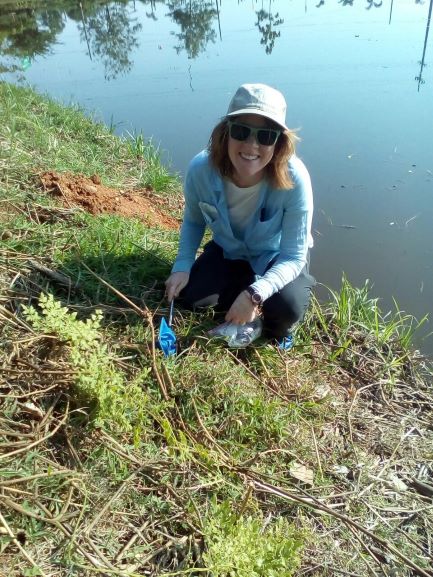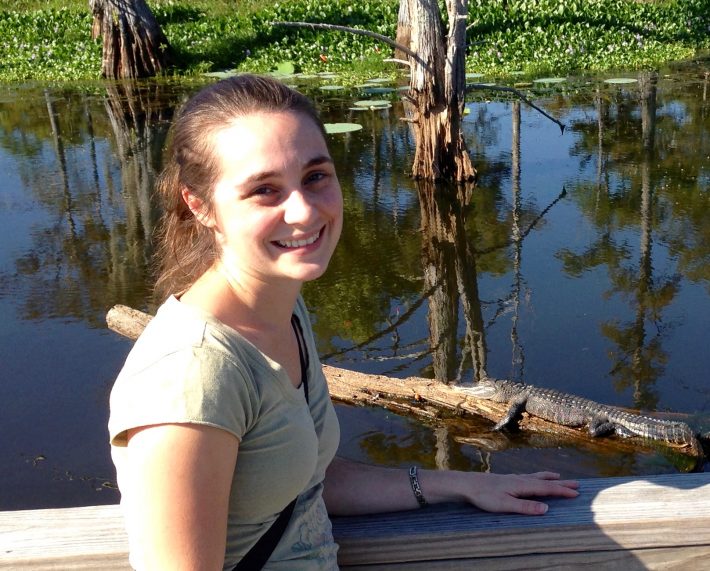Elton Prize
The Elton Prize is awarded by the British Ecological Society each year for the best research paper in Journal of Animal Ecology written by an early career author at the start of their research career. Early career is defined as less than five years post- Ph.D. or -D.Phil. experience according to the date of your graduation certificate. Reasonable exceptions will be considered (e.g. for parental leave or a substantial shift in research area). The winner of the Elton Prize will receive £500, membership of the BES, a year’s subscription to Journal of Animal Ecology, and a contribution to the costs incurred in attending the BES Annual Meeting in the UK if they wish to give a presentation on their work. The winner is selected by the Senior Editors of the journal at the end of each year and an announcement is made the following year.
If the first author of a paper considers that they are eligible for this award they are invited to nominate themselves when submitting a revised manuscript.
Winner of the Elton Prize 2023

Clara Woodie
, , , (2023). Journal of Animal Ecology, 92, 1416– 1430.
In this year’s Elton award-wining paper, Clara Woodie and colleagues take advantage of a tractable protist mesocosm system to explore how dendritic or lattice-type spatial habitat networks impact long, transient dynamics in experimental predator-prey systems. Highly structured landscapes are predicted by theory to impact rates of colonisation, extinction, and isolation of individual habitat patches, and these factors can have large and sometimes unpredictable effects on population dynamics and ecosystem stability. Predicting the outcomes of such dynamics is crucial, given increasing fragmentation of most ecosystems worldwide, and the need to plan effective conservation strategies relevant in complex landscapes. Importantly, and as investigated by Woodie and colleagues, increasingly complex habitat networks can act to extend the time frame at which local processes operate, reducing our ability to observe outcomes in the wild. In their experimental mesocosms, Green and Woodie et al. find that, in comparison to isolated treatments, more complex habitat networks can act to extend the time frame over which predators and prey can cycle in non-equilibrium (over hundreds of generations!), due to increased spatial variance in both stochastic and deterministic processes. Importantly, an extended transient phase in predator-prey interactions favours coexistence, conforming to expectations from metacommunity theory. Taken together, these exciting results clearly elucidate the role of spatial complexity to improve biodiversity outcomes by delaying prey over-exploitation. The study furthermore clearly demonstrates the value of mesocosm experiments to test theory relevant at protracted temporal scales, producing insights of wide applicability to animal population conservation and management.
About the Winner
Clara is a finishing Ph.D. candidate in Evolution, Ecology and Organismal Biology at University of California, Riverside. Her research focuses on the drivers of food web dynamics, including spatiotemporal and trait-mediated mechanisms. She is particularly interested in stabilizing mechanisms of the ubiquitous–yet theoretically unstable–intraguild predation interaction, in which a predator competes with its prey for a shared resource. Her research aims to bridge this gap between theory and the natural world. She combines theoretical methods (e.g. mechanistic modelling to develop new theory) with empirical methods (e.g. protist microcosm experiments to test theory) to uncover stabilizing mechanisms.
Read the full blog post here.
Winner of the Elton Prize 2022

Pablo Augusto P. Antiqueira
, , , , , & (2022). Journal of Animal Ecology, 91, 428– 442.
Trophic downgrading, or the loss of top predators, often has dramatic cascading consequences on the organization of communities. Similarly, ongoing climatic warming is disrupting communities and ecosystems, often in unpredictable ways. Experimentally addressing how trophic downgrading and warming interact, which they likely do, to shape communities is a daunting challenge, especially when the effects can cascade across ecosystem boundaries, say from a grassland to a pond. It’s hard to imagine what an experiment in in a place like the Serengeti might look like if we were interested removing lions from some plots but not others and experimentally warming some plots but not others. More than likely, that experiment is impossible to carry out. What’s needed is a more tractable system. Enter the tank-bromeliad system. They support a diverse fauna of micro- and macro-organisms, both in the rainwater-fed aquatic ecosystem in the central cup, or the tank, and in the terrestrial ecosystem that is not submerged in water.
In this year’s Elton Award winning paper, Pablo Augusto Antiqueira and colleagues take advantage of these tractable tank-bromeliad systems to explore how trophic downgrading and warming affect these diverse aquatic and terrestrial communities. The top predators in the tank-bromeliad system are damselfly and horsefly larvae, which are much easier to manipulate than the lions on the Serengeti. And Pablo and his colleagues came up with an innovative way to warm these ecosystems: the used aquarium heaters to increase temperatures by either 2° or 4° C above ambient temperatures. (We also note that their Figure 1 – a conceptual schematic of the tank-bromeliad system – is worthy of an award itself). They found that the loss of top predator affected different components of the tank-bromeliad system in a variety of anticipated and not so anticipated ways. For instance, the loss of the top predators increased the richness and abundance of filter feeders but decreased the richness of algae in the tank bromeliads. Warming in contrast did not affect the aquatic micro- or macro-organisms but did lead to an increase in the abundance of web-building terrestrial spiders. Taken together, their results highlight the how trophic downgrading and warming might affect species in direct and indirect ways, and across ecosystem boundaries. Pablo and colleagues have provided a clear framework for future experiments, be they with lions or otherwise, to explore how multiple anthropogenic drivers influence the structure of communities and the functioning of ecosystems.
About the Winner
Pablo is an ecologist interested in observational and experimental approaches to answer questions about the factors that regulate the community structure and ecosystem functioning. Pablo completed this research as a postdoctoral researcher working with Dr. Gustavo Quevedo Romero at the State University of Campinas (UNICAMP), Campinas, São Paulo, Brazil. Pablo is currently a postdoctoral fellow at the same university, studying anthropogenic changes, and exploring human impacts on biodiversity in urban environments.
Read the full announcement on our blog
Winner of the Elton Prize 2021

Kate P. Maia
Interaction generalisation and demographic feedbacks drive the resilience of plant–insect networks to extinctions, Kate P. Maia, Flavia M. D. Marquitti, Ian P. Vaughan, Jane Memmott, Rafael L. G. Raimundo Journal of Animal Ecology, 2021; 90:09, 2109– 2121.
The past decade has seen a burgeoning number of studies in network ecology, describing the interactions between species, the underlying structure of communities and the function and stability of ecosystems. Of the numerous ecological network properties, network ‘robustness’ (a measure of the tolerance of the network to species extinctions) has received particular attention. Our understanding of network robustness has advanced from studies of simple qualitative, bipartite mutualistic networks to investigations of patterns across ecosystems. The development of adaptive network models (ANMs) is particularly exciting, as they better incorporate the dynamics of species abundances over time with network topology, sensibly allowing interaction switches (or ‘rewiring’) to be considered. But how might the inclusion of different interaction types and feedbacks affect the long-term resilience of these networks? Kate P. Maia and colleagues addressed this challenge using ANMs to investigate the resilience of plant–pollinator and plant–herbivore networks to species loss.
In this paper, Maia et al. predicted that positive demographic feedbacks between plant and insect populations would result in longer and more frequent co-extinction cascades in pollination (mutualistic) than in herbivory (antagonistic) networks, reducing their overall resilience, and that there would be limited rewiring in the latter due to a high degree of herbivore specialisation. Through a combination of neat modelling approaches, Maia et al. found that when network structure was static, pollination networks were less resilient than herbivory networks. But when interaction rewiring was incorporated in the models, they showed that the structure of pollination networks (characterised by high generalisation) enhanced resilience to extinctions. Thus, they were able to show a link between the natural history of two plant–insect systems and the processes that shape network resilience. Finally, by running simulations on theoretical networks with controlled structures, Maia et al. created a general benchmark for the effect of network structure on robustness, which will undoubtedly help ecologists working on the resilience of different interaction networks.
According to Kate,
our work builds on the tradition of ecological network robustness analysis by adding pioneering elements: an adaptive network model which allowed us to compare empirical networks of two interaction types, a full-factorial simulation framework and a theoretical benchmark for the effects of network structure on robustness.
The Journal of Animal Ecology Editors were particularly impressed by the ways in which Kate complemented her analysis of empirical network data with theoretical networks, elegantly advancing the utility of ANMs to help elucidate important ecological and evolutionary considerations pertinent to further studies of resilience.
For Kate, much of the enjoyment in this work came from the coding challenge – this was her first experience with this level of modelling – and in designing the different scenarios for each of the questions.
This work marked a milestone in Kate’s PhD thesis, which was awarded in January 2019 by the University of Bristol, UK. At the time of the manuscript’s submission, Kate was a second-year postdoc at the University of Sao Paulo, Brazil and, even if working on different systems and approaches, has broadly continued with this research. She is currently looking for different structural patterns across networks of several interaction types and exploring how they influence the spread of effects across species.
Kate shares more insights into her work in this blog post.
Read the winning article, along with all shortlisted for the 2021 award in a dedicated Virtual Issue.
Winner of the Elton Prize 2020

Natalie Jones
Predators drive community reorganization during experimental range shifts. UrNatalie T. Jones Celia C. Symons Hamanda Cavalheri Adriana Pedroza‐Ramos Jonathan B. Shurin. Journal of Animal Ecology. 2020; 89:10, 2378-2388.
Climate change is reshuffling ecological communities, truly, as we speak; it’s not simply leading to the loss of species in local communities, as many early papers predicted. Indeed, climate change does hasten local extinctions, but it also triggers range expansions and alters interactions among resident species and, increasingly, among novel species as well. But imagine if you were asked to figure out the complicated case of how biotic and abiotic factors influence the assembly of novel communities? There’d be a lot of ins and a lot of outs; a lot of strands to keep in your head. Natalie Jones and colleagues were able to keep those strands in their heads and designed an elegant study aimed at documenting the ins and outs of the combined and relative effects of warming and fish predation on the assembly of novel zooplankton communities.
In this paper, Jones simulated warming and elevational migration by zooplankton in the presence and absence of fish predators in a mesocosm experiment. They measured changes in zooplankton community composition, population growth rates and the strength of trophic cascades. They found that the impact of warming on zooplankton community composition depended on whether colonizing zooplankton species were faced with competition from novel species or co-occurred with fish predators, which again is more than just a simply loss of species from the community in response to warming. Populations of one zooplankton species, the smallest species, typically increased in size in response to warming and populations increased in size, especially in the presence of fish predators who prefer larger prey species; larger zooplankton species could successfully colonize only when predators were absent. Finally, there was evidence of a fish-induced trophic cascade, but its strength did not depend on whether the communities were warmed or novel species were present.
Since those first projections of how biodiversity would be impacted by ongoing climate change, ecologists have learned a lot about how particular taxa in particular places are being, and likely will be, affected. Similarly, thanks in part to clever experiments and accidental introductions of novel species, we know of more novel interactions in novel communities. Finally, animal ecologists have long appreciated the role that predation plays in structuring communities. But only a carefully conceived and executed experiment could tie all of those strands together to understand the often-complicated case of how biotic and abiotic factors shape novel communities. Natalie Jones and colleagues reported on just such an experiment in Journal of Animal Ecology, and the editors are proud to award her the Elton Prize.
Natalie completed this research as a postdoctoral fellow working with Dr. Jonathan Shurin at the University of California, San Diego. She is currently a postdoctoral fellow at the University of Queensland in Australia and loves empirically testing predictions from ecological theory using different plant and animal systems.
Find out more about Natalie’s research including the biggest challenge of the work to find ‘Secret lake’ check out Natalie’s #StoryBehindThePaper blog post here.
Find the winning paper as well as the shortlisted papers for the 2020 Elton Prize in this virtual issue.
Winner of the Elton Prize 2019

Uriah Daugaard
Warming can destabilize predator–prey interactions by shifting the functional response from Type III to Type II. Uriah Daugaard Owen L. Petchey Frank Pennekamp Journal of Animal Ecology. 2019; 88:10, 1575– 1586.
A topical challenge in ecology is to understand how temperature affects the complex ways in which species interact, with important implications for community structure, dynamics and ultimately stability. For example, it is known that rising temperatures can strengthen predator-prey interactions by increasing the feeding rate of predators. But how warming influences the dependency of predator feeding rates on prey abundances (traditionally categorized into Type I, II and III functional responses) is poorly understood. This is important as the type of functional response has a strong effect on population and community stability.
In this paper, Uriah and colleagues provide a fine example of how a combination of experimentation and modelling, using a ciliate predator-prey study system, can bring to light an important mechanism by which warming affects stability. Uriah found that increasing temperature can destabilize predator-prey interactions by shifting the interaction from Type III (stabilizing) to Type II (destabilizing). This under-appreciated mechanism has a range of implications for numerous theoretical studies, which have hitherto ignored it, hence the results of the study are likely to make a significant contribution to the field.
In choosing a winner for this year’s Elton Prize, the Editors were also impressed how Uriah had designed, executed and mostly completed this paper as an undergraduate. His critical thinking and attention to detail including some smaller experiments to minimize measurement error is apparent throughout the paper and exemplifies the quality and standard of work we expect at the Journal of Animal Ecology.
Uriah Daugaard began the work that led to this publication during his Bachelor of Science studies in Biology at the University of Zurich. The project was concluded during his Master of Science studies in Biostatistics at the same university, from which Uriah graduated in March 2020. In May 2020 Uriah is starting his PhD studies in Ecology with Prof. Dr. Owen Petchey at the University of Zurich. For his doctorate studies, he will work on the Swiss National Science Foundation project Advancing the limits of ecological forecasting in changing environments using very long-term experimentation with micro-ecosystems. In this project, laboratory-based aquatic ecosystems composed by diverse bacteria, protists and metazoans will be used to thoroughly sample a wide range of variables – from individuals to the ecosystems as a whole – over thousands of generations and under multiple treatments. The general aim is to explore the limits of how forecastable the different variables are and to determine the biological mechanisms that lead to the differences in the observed forecast skill of these variables.
Find the winning paper as well as the shortlisted papers for the 2019 Elton Prize in this virtual issue.
Winner of the Elton Prize 2018

Hannah White
Contribution of local rarity and climatic suitability to local extinction and colonization varies with species traits. Hannah J. White, Ian W. Montgomery, Jack J. Lennon Journal of Animal Ecology 2018, 87:6 pp 1560– 1572.
In this paper, Hannah and colleagues seek to connect four key themes in animal ecology: abundance, spatial distribution, climate change and species-specific traits, and apply these to data to ask which of these, and their combinations best explain distributional changes of birds across Britain over decadal time scales. They use data collected as part of huge ‘citizen science’ efforts by ornithologists across the UK, under the auspices of the British Trust for Ornithology atlas projects form the 1960s to 1990s. Their paper sets out what is a complex statistical modelling exercise with admirable clarity, and also presents the results in clear, informative and easy to comprehend tables and graphics. The paper shows that understanding changes in the distribution of birds at this scale (both colonisations and extinctions) requires knowledge of both climatic suitability and measures of local rarity (defined as the extent to which local patches are surrounded by occupied patches). It further shows that these effects are moderated by some species-specific characteristics (all of this analysis performed under a rigorous phylogenetically controlled framework), but that by far the most important character is the range size of a species. The results are important because they both provide an example of the joint effect of climate and local rarity in understanding population processes, but also because they provide such a clear framework to enable analyses extended to other spatial and temporal scales, and to other taxa.
Hannah White completed her PhD in Macroecology at Queen’s University Belfast in 2016 under the direction of Jack Lennon. Her thesis investigated spatiotemporal patterns of ecological traits and functional diversity in birds and plants, to which this paper contributed. Dr. White is currently a Postdoctoral Researcher at University College Dublin studying grassland resilience at multiple spatial scales across the island of Ireland through the use of remotely sensed data in conjunction with on-the-ground measurements. Her overall research spans macroecology and spatial ecology covering a multitude of taxa but focuses on the underlying mechanisms that shape patterns of biodiversity, in particular ecological trait diversity, and how these relate to ecosystem functioning across landscapes.
Find the winning paper as well as the shortlisted papers for the 2018 Elton Prize in this virtual issue.
Winner of the Elton Prize 2017

Natalie Clay
Towards a geography of omnivory: Omnivores increase carnivory when sodium is limiting Natalie A. Clay, Richard J. Lehrter, Michael Kaspari Journal of Animal Ecology, 2017, 86:6 pp1523–1531.
Charles Elton led the way in conceptualizing ecological pyramids as a way to describe how feeding relationships are structured in ecological communities. Since his pioneering work more than ninety years ago, animal ecologists have made great theoretical and empirical strides in documenting both the structure and dynamics of feeding relationships (e.g., food webs, food chains, etc.) among organisms. Beginning about 30 years ago, a growing number of ecologists began to explore the consequences of omnivory – feeding on both plants and animals – on food web structure. So, while we know more about the consequences of omnivory, does omnivory vary geographically, and if so, why?
Cue Dr. Natalie Clay. In a crystal clear and wonderfully written paper, Dr. Clay describes how she and her collaborators took advantage of natural gradients in net primary productivity (NPP), sodium (Na) deposition, Nitrogen (N) and, climate at 20 sites in the eastern United States to test whether (and why) omnivory in ant communities varies geographically. At each site, she used a tried and true method to document foraging behaviour and resource limitation in ant communities (in this case, different resources offered in plastic vials) and coupled those observations with stable isotope analyses. After documenting the feeding behaviour of more than 18,000 ants from 72 species at 20 sites from Georgia to Maine, Dr. Clay discovered that omnivory does, in fact, have a geography. And more interestingly, when she compared the effects of NPP, Na, and N on the degree of omnivory in ants, she found that best predictor was Na availability. This is a surprising and important result for several reasons (which Dr. Clay and her colleagues describe in their paper), but chief among those reasons is the novel result that because consumers are Na-limited, geographic or temporal variation in Na availability should have cascading consequences on ecological pyramids, and the diverse suites of interactions that tie species together in ecological communities. So not only is there a geography of omnivory, but Dr. Clay and her colleagues show why. She then extends the work by pointing out that humans are altering Na deposition, and this will likely have important, and perhaps predictable, consequences on food webs, and likely the ecosystems in which they are embedded. In sum, Dr. Natalie Clay’s cutting-edge work extends Elton’s ideas and opens up broad avenues for future research on the structure and dynamics of food webs.
With the aim of introducing a fairer and more robust process for choosing a winner, this year the Senior Editors decided to enlist the help of our expert Associate Editors to help choose the winning paper. To choose the winner the Senior Editors shortlisted 12 papers from the long list entrants, the Associate Editors were then invited to score the papers against an agreed set of criteria, the scores from the Associate Editors’ reports where then used to determine the winner. We are grateful to Xingfeng Si, Dehua Wang, Mariano A. Rodriguez-Cabal, Dylan Childs, Ann Tate, Daniel Ardia, Marta Rueda, Ronald Bassar, Carola Gomez-Rodriguez, Gabriel Machovsky-Capuska, Fanie Pelletier, Xuan Liu, Bethany Hoye, Lise Aubry and Garrett M. Street for reviewing and scoring the papers.
Natalie Clay obtained her PhD from the University of Oklahoma in the Ecology and Evolutionary Biology Program in 2013 under the direction of Michael Kaspari. Her dissertation research examined the relationship between nutrient inputs like sodium on the structure and function of detrital communities, including trophic ecology. She conducted her postdoc research with John Riggins at Mississippi State University looking at the interactions between bluestain (ophiostomatoid) fungi, which is vectored by bark beetles, and subterranean termites and the impacts of these interactions on wood decomposition processes. Dr. Clay is currently an assistant professor in the School of Biological Sciences at Louisiana Tech University. The Clay Ecology Lab uses invertebrates like ants, termites and other detrital organisms to explore how nutrient availability alters detrital pathways and how multitrophic interactions impact ecosystem functions like decomposition processes.
Read the Virtual Issue bringing together the winning and highly commended papers from all the BES journals in 2017.
Winner of the Elton Prize 2016

Roberto Salguero-Gómez
COMADRE: a global data base of animal demography Roberto Salguero-Gómez, Owen R. Jones, C. Ruth Archer, Christoph Bein, Hendrik de Buhr, Claudia Farack, Fränce Gottschalk, Alexander Hartmann, Anne Henning, Gabriel Hoppe, Gesa Römer, Tara Ruoff, Veronika Sommer, Julia Wille, Jakob Voigt, Stefan Zeh, Dirk Vieregg, Yvonne M. Buckley, Judy Che-Castaldo, David Hodgson, Alexander Scheuerlein, Hal Caswell, James W. Vaupel (Journal of Animal Ecology, 85:2, pp 371-384)
Demographic information is key for answering many of the questions evolutionary ecologists, population biologists, and scientists involved in management and conservation have to tackle. However, demographic information can be quite difficult to obtain, and results from detailed case studies that are scattered in a vast array of written accounts, including scientific papers and management reports. A tool for synthetizing the vast amount of accumulated demographic information was, until recently, lacking. Such a tool is sorely needed, especially nowadays when comparative analyses of life history traits have become a gold standard both for better understanding the diversity of life histories across the tree of life and for improving our knowledge about population dynamics of threatened (or exploited) species or populations. In this paper, Rob Salguero-Gomez and his co-authors fill this gap nicely by providing the missing tool in the form of an open animal matrix database (called COMADRE) that includes 1625 population projection matrices offering demographic information for 345 animal species. They show that, once properly standardized, demographic traits can be compiled across animal species with highly different life cycles and offer the necessary basis to support comparative demographic analyses at an unprecedentedly large scale of biological organization. The editors thought that the paper fills an important knowledge gap in animal ecology by providing the missing information to perform demographic analyses at both intra- and inter-specific levels. This paper makes an excellent contribution to Journal of Animal Ecology and it has already been spotted as a key paper by the scientific community by quickly becoming the most downloaded paper published in Journal of Animal Ecology in 2016. The editors were also impressed by Rob’s ability to coordinate so successfully this huge work that involved a large network of people.
Rob Salguero-Gómez obtained his PhD in Ecology & Evolution at the University of Pennsylvania in 2011, and he is currently the leader of the SalGo Team. His group’s research explores the determinants of large natural variation found among the life history strategies of animals and plants worldwide, for which he uses a combination of field, experimental and large-data approaches. He is also the co-leader of the COMADRE Animal Matrix Database and the COMPADRE Plant Matrix Database and holds honorary fellowships at the Max Planck Institute for Demographic Research (Germany), the University of Queensland (Australia), and Trinity College Dublin (Ireland). Rob will soon be joining the faculty of the Department of Zoology of the University of Oxford, where he will continue to develop the COMADRE database, as well as exploring the role of trade-offs in the evolution of senescence, with a particular emphasis on demographic oddities, such as animals that demographically behave like plants (e.g. corals, sponges, etc.), and plants that behave like animals (sundews, venus traps, heterotrophic plants, etc.).
Read the Virtual Issue bringing together the winning and highly commended papers from all the BES journals in 2016.
Winner of the Elton Prize 2015

Jonathan Pruitt
Animal personality in a foundation species drives community divergence and collapse in the wild
Jonathan N. Pruitt and Andreas P. Modlmeier (Journal of Animal Ecology, 84: 1461–1468)
Charles Elton once quipped that “Ecology consists of saying what everyone knows in language that nobody can understand.” Maybe that is true for much of ecology, but it is certainly not the case with the paper by Jonathan Pruitt and Andreas Modlmeier “Animal personality in a foundation species drives community divergence and collapse in the wild.” Does everyone know that spiders have personality? And the prose in Pruitt and Modlmeier’s paper is both clear and vigorous, so readers can definitely understand it. The editorial board was impressed by the creativity of Dr. Pruitt’s work, its rigor, and the conceptual ties it made among the sometimes disparate fields of behavioral ecology and community ecology. Indeed, this paper stood out among many excellent papers in JAE in 2015. Therefore, the editorial board is happy to award the 2015 Elton Prize to Dr. Jonathan Pruitt.
Pruitt and Modlmeier examined how personality in the spider Anelosimus studiosus influences a suite of other spider species over 7 years in the field. Either aspect of the study – examining the extended consequences of personality in A. studiosus or tracking spider community dynamics for 7 years – would be interesting enough. But what Pruitt and Modlmeier showed was that the spider communities associated with webs of docile A. studiosus individuals differed from those associated with webs occupied by aggressive A. studiosus individuals, at least initially. Numerous other studies, mostly in plants, have shown how variation among individuals can lead to cascading community- and ecosystem-level consequences, but much of that work has failed to examine the temporal dynamics of communities associated with particular phenotypes. Here, Pruitt and Modlmeier, because they tracked these communities for seven years, are able to examine early succession, convergence, and ultimately the collapse of spider communities. They conclude that it is possible to use the traits of these initial spider species to predict the rate and path of succession, divergence, convergence, and collapse among the rest of the spider community. In sum, these clever experiments and persistent sampling yield novel insights into how the behavior of individuals scales up to influence the dynamics of communities. We now know that such links are common in nature, but few studies have characterized the links so explicitly. This kind of ecology is the kind of ecology that more people should know about, and they will, because it’s written in a language they can understand.
Jonathan Pruitt performed his graduate studies at the University of Tennessee, Knoxville under the direction of Susan Riechert. He then conducted postdoctoral studies at the University of California, Davis with Andy Sih and Jay Stachowicz. He is presently an assistant professor in the Department of Ecology, Evolution and Marine Biology at University of California, Santa Barbara.
The Pruitt Lab’s research explores the ecological consequences of individual variation in behavior for individuals, populations, and communities. His lab uses a variety of invertebrate models, especially social spiders, to address these topics. More deeply, the research considers the role of individual variation in structuring patterns of task allocation within societies and how these patterns impact the long-term performance of groups in contrasting environments. In non-social systems, Pruitt and his lab consider how variation in behavior impacts species interactions within and across multiple trophic levels. These studies have been conducted in a variety of both terrestrial and marine systems.
Winner of the Elton Prize 2014
James Maino
The 2014 Elton Prize winner is James Maino for his paper Reconciling theories for metabolic scaling co-authored with Michael R. Kearney, Roger M. Nisbet and Sebastiaan A.L.M. Kooijman (Journal of Animal Ecology, 83: 20–29).
Metabolic theory specifies constraints on the metabolic organisation of individual organisms and has important implications for scaling up from individuals to ecosystems. In this paper, James Maino and his co-authors attempt to reconcile different theories to explain this metabolic scaling. They show that two prominent ideas in metabolic scaling are not necessarily mutually exclusive, and they present a modified framework based on the fundamental processes of acquiring and using pools of stored metabolites which allows both intra- and inter-specific comparisons to be made. The editors thought that the paper was innovative and liked that James and his co-authors tested a priori predictions from their parameterised model against a real dataset for mammalian respiration, with encouraging results. This paper made an excellent contribution to the Journal’s recent Special Feature on “Metabolic Constraints and Currencies in Animal Ecology”, and it has already sparked significant interest in this exciting and controversial field of ecology
Our Elton Prize winner, James, was the lead author of this paper and the editors were impressed that this was his first publication written when he was still in the first year of his PhD. James’ PhD is part of a jointly awarded program between the University of Melbourne and Vrije Universiteit (Amsterdam). His research explores patterns in animal life-history that hold across diverse species and looks into what extent they can be explained by universal physical and chemical constraints. James utilises Dynamic Energy Budget theory in combination with large data sources on the diverse life histories of insects to develop mechanistic models of animal bioenergetics. The resulting mechanistic models explain a variety of well-known but poorly understood patterns in biology, from metabolic scaling to U-shaped pupal respiration in insects.
Winner of the Elton Prize 2013
Chuan Zhao
The Editors of Journal of Animal Ecology are pleased to announce that the 2013 Elton Prize winner for papers published in Volume 82 is Chuan Zhao from Chengdu Institute of Biology, Chinese Academy of Sciences.
Chuan’s paper Predatory beetles facilitate plant growth by driving earthworms to lower soil layers is co-authored with John Griffin, Xinwei Wu and Shucun Sun.
In the paper, Zhao and colleagues tested the hypothesis that predators will have negative effects on plants by suppressing detritivores in a Tibetan alpine meadow, and they did this by manipulating predatory beetles and examining indirect effects transmitted through their earthworm prey. The Editors particularly liked the neat design of this experimental study and the interesting results that emerged, which did not accord with conventional theory – the authors discovered that predators actually enhanced the positive effects of detritivores on plants. Moreover, the Editors appreciated that the authors had worked to demonstrate a plausible and interesting mechanism to explain this counter-intuitive result: a non-consumptive effect, by which the largely aboveground predatory beetles drive earthworms deep into the soil in a bid to escape predation risk, leading to increased porosity, water content and available nutrients in the otherwise barren lower soil layer. Overall, this work also adds a completely novel aspect to the highly topical issue of how predators influence plants and ultimately ecosystem functioning in terrestrial ecosystems.
The paper formed part of Chuan Zhao’s PhD dissertation, and he designed the experiment with his advisor, performed all the experimental procedures and examinations, and wrote the first draft of the manuscript. He is currently a research assistant in Chengdu Institute of Biology, Chinese Academy of Sciences, and plans to continue studying trophic interactions in the alpine detritus system. In fact, Chuan has recently published another paper in JAE using the same system.
Winner of the Elton Prize 2012
Sonya Auer
The Editors of Journal of Animal Ecology are pleased to announce the winner of the Young Investigator Prize 2012 for papers published in Volume 81 is Sonya Auer from the University of Montana.
Sonya’s paper Life histories have a history: effects of past and present conditions on adult somatic growth rates in wild Trinidadian guppies is co-authored with Andrés Lopez-Sepulcre, Thomas Heatherly II, Tyler J. Kohler, Ronald D. Bassar, Steven A. Thomas and David N. Reznick.
In the paper, Auer and colleagues examined the effects of variation in food availability across life stages on growth rates in wild Trinidadian guppies (Poecilia reticulate).The Editors and reviewers liked the elegant study system used, the detailed analyses, and the surprising and fascinating results that emerged from the investigation. The authors found that food availability and population density at different points in guppy development can have contrasting effects on adult somatic growth rate. Previous studies had only examined the effects of environmental variation within and across life stages in isolation, and thus their relative influence and subsequent importance remained unexplored.
Sonya carried out this work during her PhD in the lab of David Reznick at University of California-Riverside, which she completed from in 2011. She is currently a post-doctoral researcher at Montana Cooperative Wildlife Research Unit, University of Montana. Here, her current research focuses on breeding bird responses to extreme weather events and general increases in temperature associated with current climate change. In particular, she is examining how temperature influences avian growth and development and how these effects may differ across species. Finally, she is also looking at how other breeding strategies such as nest site selection are changing in response to increased warming in the southwestern United States.
Winner of the Elton Prize 2011
Philip Matich
Philip’s paper Contrasting patterns of individual specialization and trophic coupling in two marine apex predators is co-authored with Michael R. Heithaus and Craig A. Layman and was published in Volume 80, Issue 1, pages 294–305.
This analysis used stable isotopes to reveal the generalist diet of tiger sharks versus a more specialised diet of bull sharks and, furthermore, how individuals within these species could often have specific diets, presumably linked to local resources and competition.
Winner of the Elton Prize 2010
Nelika Hughes
Nelika’s paper was entitled Interacting effects of predation risk and signal patchiness on activity and communication in house mice and was published in Volume 79, Issue 1, pages 88–97.
In this study, Nelika, with co-author Peter Banks, uses the house mouse to examine how the spatial distribution of conspecific scent signals and the perceived level of predation risk from cats affect mouse behaviour and overall activity across a range of spatial scales.
Winner of the Elton Prize 2009
Michael Sheriff
Michael co-authored his paper The sensitive hare: sub lethal effects of predator stress on reproduction in snowshoe hares (Volume 78, Issue 6, pages 1249–1258) with Charles J. Krebs and Rudy Boonstra.
This is the first study in a free-ranging population of mammals to show that elevated, predator-induced, cortisol concentrations in individual females caused a decline in their reproductive output measured both by number and quality of their offspring.
Winner of the Elton Prize 2008
Meggan Craft
Meggan Craft won the 2008 Elton prize for her paper with Hawthorne P. L., Packer C. and Dobson A. P. Dynamics of a multihost pathogen in a carnivore community (Journal of Animal Ecology – Volume 77, Issue 6, pages 1257–1264).
The Editors chose Meggan’s paper because her analyses evaluated different hypotheses of disease spread against empirical data from a 1994 outbreak of canine distemper in African lions. This study not only sheds light on the number of likely hosts from the lethal 1994 Serengeti outbreak, but also generalizes the role that social structure can play in disease dynamics. Meggan’s article generated considerable interest and was selected as the subject of the In Focus article in Volume 77, Issue 6 (Haydon 2008).
Like what we stand for?
Support our mission and help develop the next generation of ecologists by donating to the British Ecological Society.